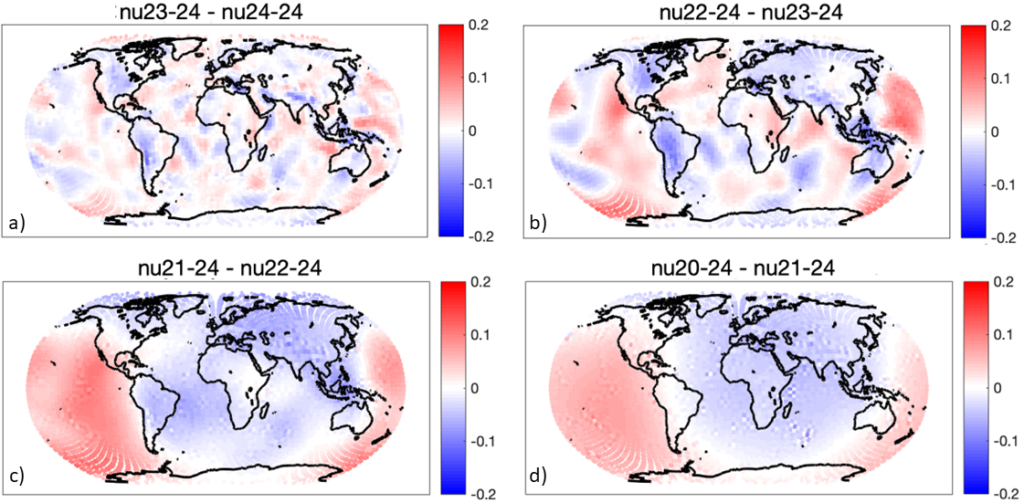Task 5: The sensitivity analysis of the effect of mantle stress to the lithospheric model, WINTERC-G
In this first phase of the project, we will conduct a full sensitivity analysis of dynamic topography as a key element to constrain the crustal structure, transition zone, lower mantle and CMB topography. This will be in connection to other relevant tasks in the project (electrical conductivity, dynamic topography, petrology).

In order to make the joint geodynamic-geophysical inversion feasible at a global scale at a physically meaningful lateral resolution, the UCM group (Olga Ortega, ESA Living Planet Fellow) has started applying a state-of-the-art numerical technique (Model Order Reduction, MOR), in particular the Reduced Basis method (Quarteroni et al., 2016; Hesthaven et al., 2016; Ortega-Gelabert et al., 2020), to efficiently evaluate dynamic topography solving the Stokes flow problem. MOR is a very attractive and relatively novel methodology in the Earth science community. Reduced-order techniques are a family of approximation methodologies based on the common idea of expressing the solution of a problem in a low dimensional space in which, consequently, it is faster to compute (e.g., Chinesta and Ladevèze, 2014; Ito and Ravindran, 1998; Ravindran, 2000). These techniques are especially tailored to solve a large number of problems with similar characteristics.

On the other hand, the effective viscosity of crustal and upper mantle minerals depends on the strain rate, temperature, grain size, melt fraction and water content according to laboratory experiments (e.g., Mei et al., 2010; Karato, 2012; Faul and Jackson, 2015). In this project we will use state-of-the-art experimental rheological parameters for the most relevant crustal and upper mantle minerals (quartz, feldspar, diabase, pyroxenes, olivine) to consistently characterize the lateral and vertical viscosity variations related to the thermochemical structure and melt and water content distributions in the lithosphere and underlying upper mantle.
Workpackages Task 5
Sensitivity tests:
• Test different strategies to sample the parametric space in order to build a representative reduced basis.
• Does an “on-the-fly” approach to sample the parametric space bring any improvement with respect to traditional offline-online strategies?
• How to parametrize the density and viscosity fields to minimize the number or parameters while keeping them representative enough?
Sensitivity tests:
• Impact of different experimental parametrizations of mantle viscosity and the effect of melt and water (link to magnetic and petrology tasks).
• How much variation in viscosity is necessary for a certain change in dynamic topography? Does it affect wavelength and amplitude in a similar way.
• At which depth changes in viscosity produce a larger effect on the dynamic topography? Does it affect wavelength and amplitude in a similar way?
• How does the viscosity profile (radial profile versus laterally varying profile) affect the amplitude and wavelength of the topography?
• Estimate the flexural contribution to topography in the intermediate wavelengths (100 km < λ < 1200 km) based on the rigidity of the lithosphere, i.e., the elastic thickness from WINTERC-G lithospheric model.
Sensitivity tests:
• Different coupling strategies (e.g., modifying the crust and/or lithospheric mantle vs sublithospheric mantle) accounting for the bimodal distribution of the crust (oceans vs continents).
• Analysis of the different wavelengths in residual topography: possible wavelength based strategy in the coupled inversion.
• Sensitivity kernels calculated with Different methods (reduced basis probabilistic, adjoint): Effect of thermal and chemical lithospheric and sub-lithospheric mantle changes in the predicted dynamic topography and gravity field (link to seismology +gravity and petrology tasks).
• Analysis of lithological variations in the crust: density and seismic velocity variations and their effect in isostatic topography and seismic tomography data (link to seismology and gravity sensitivity analyses).